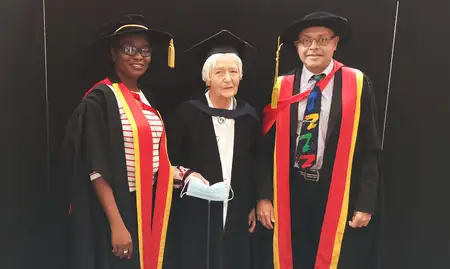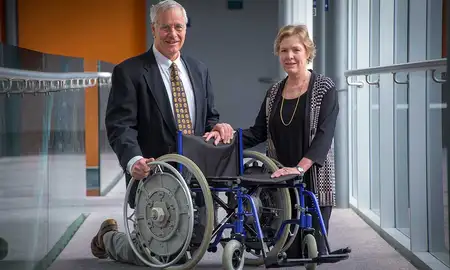
Dr Claire and Dr Rory Flemmer.
Newly branded as OctalWheels™, the design of the revolutionary wheelchair went through 23 prototypes and 37 years of research and development to become a world first in providing users a way to increase their daily activity. With innovative handles and three gears for the speed to keep up with an able-bodied runner, OctalWheels is removing the barriers preventing wheelchair users from participating in regular life routines.
Dr Claire Flemmer is a Senior Lecturer in Building Technology with nearly 40 years of experience in industrial robotics and automation. She says all these years of work can solve part of the problem faced by wheelchair users.
“Wheelchair users need to exercise the same as abled bodied people do, but it’s often harder. Less than 15 per cent of wheelchair users get enough to benefit their health and then you’ve got to consider their mental health. Getting out can be too difficult, which can make their world so much smaller. OctalWheels is designed to be their own gym and remove those obstacles for a more accessible life,” Dr Claire says.
“The issue with a standard wheelchair is only a quarter of the stroke pushes you along – the rest is jerking your arm back to get ready for the next stroke. The faster you go, the more jerking you do with less propulsion. It’s difficult to go fast and get exercise unless you are a dedicated athlete and it can also cause damage to the users’ shoulders over time. The heart of our invention is that the chair captures the forward push to go forward and captures the backward pull to also go forward, creating twice the power. The user’s hand never lets go so all their effort goes into propulsion, with no flailing at any speed.”
The other significant features of OctalWheels’ design include having handles that fold out while in fast mode to avoid user’s having to rely on a pushrim that can get cold, wet or dirty when used outdoors, and that the chair can be switched from an outdoor chair back into a standard indoor chair.
The chair has also been designed to neutralise cross-slope of the path, a necessary feature as many pathways have been designed to allow for rainwater run-off. Traditionally, users would have to push harder on one wheel than the other to remain straight, but OctalWheels has an Autopilot device that controls the movement.
Dr Claire says a lot of the feedback they’ve received in market research has been about wheelchair users wanting to get out and about, as well as getting exercise.
“OctalWheels users have said they are able to go more places where standard wheelchairs would struggle and they can keep up with friends and family. OctalWheels goes three times faster than a standard wheelchair, so rather than having someone push them or going slowly, we’ve had people excited they can go for a real walk alongside a companion. You take that for granted when you’re able-bodied, but for them it makes a huge difference.”
The success of OctalWheels has been a story of persistence, starting back in 1986 when Dr Claire and Rory Flemmer were two young academics in New Mexico and were inspired to make a change after witnessing a woman struggle to get up a ramp in her wheelchair.
By the time they arrived at Te Kunenga ki Pūrehuroa Massey University in 2005, they were on their 10th prototype. In the years following, the design underwent extensive research, with many students involved in the development. In 2018, Dr Rory made the decision to conclude his time with Massey where he was teaching mechatronics courses and devote himself full time to OctalWheels, known back then as Ezy-wheels.
Dr Rory says it would’ve been impossible to get to this point without external support and having a high level of confidence and optimism.
“It’s no simple thing to propose to build a better wheelchair than anyone in the world has over the last 120 years. If you’re undertaking a world-changing project, you’ve got to have faith and believe the effort is going to succeed. With every pushback, we had to remember that people actually needed this product. We have robust souls, but we also had help to keep us going. Massey provided a wonderful, supportive environment for research and Callaghan Innovation gave us two grants, without which we would be years behind where we are now.”
OctalWheels is now officially out on the market and the duo can begin to see the fruition of their hard work over the decades. However, the wheelchair is only one half of the equation and Dr Claire is now setting out to challenge the other half. She is supervising research at Massey focusing on examining the existing problems for wheelchair users in built environments.
She says while Aotearoa New Zealand does well in the world in terms of building access, there is a long way to go.
“There are specific building standards to assure equal accessibility in the built environment, but they aren’t being met and this can cause real problems for wheelchair users. It’s not just accessing the building interior, but also being able to use the carpark and the outdoor path to get into the building. We’ve designed the wheelchair but that only gets us half of the way. The problem is that not enough people are indignant about what wheelchair users go through and it is that indignation that is a catalyst for real change. It was for us.”
Hear more about the OctalWheels journey below:
Related news
85-year-old master’s graduate ready to embark on PhD journey
At 85 years old, one would think Margaret Stefanitsis would be relishing a quiet retirement without the pressure of deadlines and research to worry about but she has a different path in mind.

Wheelchair revolution
A new wheelchair prototype with an innovative propulsion system has been developed by Massey University engineers that attempts to minimise chronic shoulder and wrist problems for self-propelled wheelchair users, while making it easier for users to travel uphill.
